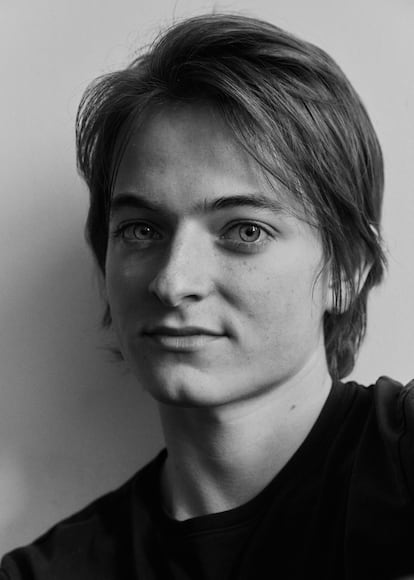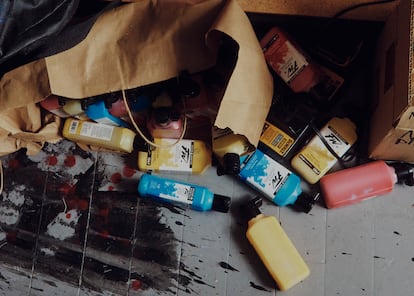Asher Liftin, the child prodigy discovered by filmmaker Wes Anderson, points out where the future of art lies
The 25-year-old artist, whose work appears in the 2012 film ‘Moonrise Kingdom,’ sells paintings to famous clients, such as producer David Geffen, or Jan Koum, the founder of WhatsApp. Liftin is also in favor of images created with the help of artificial intelligence

Can we finally declare that the label “contemporary art” has become ancient, so that we can begin the search for a new one to describe what’s happening in 2024? The American painter Asher Liftin is 25-years-old. Inevitably, one turns to him for insight, as if he were the oracle who can predict what’s to come. Or, rather, what’s already here (we just don’t know about it).
Liftin is one of the first successful artists from the generation that completed its university studies via Zoom. Discovered on Instagram by the great curators of art, he has normalized artificial intelligence as a simple work tool and a potential starting point for artists. “I was never one of those people who sat down with a pad and a pencil to draw something that came from my imagination,” he shrugs, during his interview with EL PAÍS, which takes place in his studio in New Haven, Connecticut.
But don’t get the wrong idea. He has nothing to do with the nihilism associated with generation Z, nor with the new influencer plutocracy. His large-format paintings are a revision of pointillism, filtered by glimpses of abstract expressionist Jasper Johns. He deeply admires the French avant-garde painter Francis Picabia. And, when he makes his case in favor of images created with artificial intelligence, he mentions the trompe-l’oeil technique, or the hybrid photographs of the Canadian Paul Wall.
Perhaps what most justifies his pictorial style is that the New York-born Liftin studied at Yale University, where — in addition to Art — he studied Cognitive Sciences. To top off his status as a child prodigy, he made his debut with Wes Anderson in the film Moonrise Kingdom (2012) at the young age of 12. “A teacher told me that Anderson was looking for artists in schools for his new film, because the protagonist was my age. [The teacher said] I should send him my CV, which was a little absurd, because what kind of CV are you going to have at the age of 12? I painted some watercolors, I sent them and they chose me,” he recalls.

Despite this promising start, Asher Liftin never thought he would make a living from art. Hence, he decided to complement his training with scientific thinking. In the end, however, this only reinforced his artistic vision, in the opposite way to how the Jacquard loom (another of his references, patented in 1804) became a predecessor of computer programming.
When he stepped away from painting during the pandemic — “I didn’t want to paint on Zoom” — he became obsessed with Italian director Michelangelo Antonioni’s film Blow-Up (1966), in which a photographer believes he has discovered hidden and transcendent realities in the enlargements of his own images.
The labyrinths of image perception and the information flow of the digital age became his muses. “When you see a painting, something captivates you, because there are a series of intermediate processes that generate a certain feeling in you… but you don’t perceive them. In the same way that a tweet or an Instagram post goes viral and generates an emotional reaction or a sensation of truth, the more it multiplies online. Being aware of that relationship between speed and ferocity is very interesting,” he notes.
For this reason, in his paintings, he seeks an immediate, captivating esthetic impact, but one forged in an almost laboratory process. His technique is complex — practically scientific — which hides a meticulous process, a theoretical framework and some details that border on the subliminal. He enjoys and measures the intermediate steps.
Returning to the Jacquard loom, he feels that his way of painting is almost like weaving a tapestry. He begins to build out his images in gray, adding layers of color, enriching them with translucent ink, generating geometric stencils, forming games of mirrors and textures. Like the great impressionists of the past, he enjoys when the figurative becomes abstract upon being in close proximity to the viewer.



It sounds brainy, but everything about it is playful. And it seems that he greatly amused an art curator, who saw Liftin’s art on Instagram and subsequently rolled out the red carpet for him at a Milan-based gallery: Galleria Alessandro Albanese. This would end up being his first international solo exhibition. He titled it Blow-Up, after the movie he loves.
His exhibition happened in 2022, the same year he graduated from Yale. “That first exhibition in Italy was really exciting, because there was a lot of Italian cinema present in those paintings. I had hoped to sell a couple of them.”
It turns out that billionaire David Geffen would be one of his first buyers. And, by the time he returned to New York in 2023 with his exhibition Error Signals — which opened at the Nino Mier Gallery — peculiar members of the elite had discovered his work. These included Jan Koum, co-founder of WhatsApp, or Gary Steele, president of Cisco. Technological fortunes were attracted to this hybridization of art and cognitive sciences.

“There have been people who have really supported my work,” he says modestly. His studio is also relatively modest, located in the same town where his alma mater is located.
Liftin takes us out to grab a sandwich. “In New York, the spaces are very small and my paintings are very large,” he summarizes. Here, in New Haven, the only window in his studio became his muse for a series of paintings (Studio Window, I, II and III) that later expanded the horizons of the walls of a gallery.
On the walls of his studio, meanwhile, he has portraits of colleagues (Ariadne, 2023), several postcards and, of course, the art he’s currently working on, dominated by still lifes.
“[As a genre], still life has been such an easy object for conventions. It has so many precedents in the history of art that, if you take it apart and make it feel strange, people, when they look at it, establish a contradictory relationship with the object. And I like that,” he admits. That’s why — in what he defines as a nod to the mannerist 16th century artist Parmigianino — you see him reflected in the vase that appears in one of his recent paintings, taking a photo of it with his mobile phone.
Is this meant to be a 2024 version of The Arnolfini Portrait (1434), which experimented with mirrors? Is it post-contemporary art? Call it whatever you want, but know that, with Liftin, we’re in good hands.
Sign up for our weekly newsletter to get more English-language news coverage from EL PAÍS USA Edition
Tu suscripción se está usando en otro dispositivo
¿Quieres añadir otro usuario a tu suscripción?
Si continúas leyendo en este dispositivo, no se podrá leer en el otro.
FlechaTu suscripción se está usando en otro dispositivo y solo puedes acceder a EL PAÍS desde un dispositivo a la vez.
Si quieres compartir tu cuenta, cambia tu suscripción a la modalidad Premium, así podrás añadir otro usuario. Cada uno accederá con su propia cuenta de email, lo que os permitirá personalizar vuestra experiencia en EL PAÍS.
¿Tienes una suscripción de empresa? Accede aquí para contratar más cuentas.
En el caso de no saber quién está usando tu cuenta, te recomendamos cambiar tu contraseña aquí.
Si decides continuar compartiendo tu cuenta, este mensaje se mostrará en tu dispositivo y en el de la otra persona que está usando tu cuenta de forma indefinida, afectando a tu experiencia de lectura. Puedes consultar aquí los términos y condiciones de la suscripción digital.
More information
Archived In
Últimas noticias
Most viewed
- Sinaloa Cartel war is taking its toll on Los Chapitos
- Oona Chaplin: ‘I told James Cameron that I was living in a treehouse and starting a permaculture project with a friend’
- Reinhard Genzel, Nobel laureate in physics: ‘One-minute videos will never give you the truth’
- Why the price of coffee has skyrocketed: from Brazilian plantations to specialty coffee houses
- Silver prices are going crazy: This is what’s fueling the rally










































